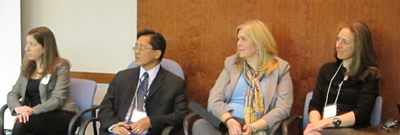Future Federal Directions in Mobile Technology and Health

Co-authored by Michele Clark, Managing Director
What is the role of mobile technology in Federal government health communication? Where are we going?
At last week's Federal HIV/AIDS Web Council (FHAWC).
We heard a snapshot of issues related to the Federal government and mobile. Here are some highlights (and we'll be sharing more information about this in the weeks to come):
Susannah Fox, Associate Director of Digital Strategy at The Pew Internet & American Life Project, kicked off the panel with a presentation on “Where is the Public Now? Mobile, Social, Games, Text…and Healthâ€ÂExit Disclaimer. She shared that 80% of people look online for health information -- and that many people are accessing the internet on mobile phones and game consoles. According to Susannah, "If someone has access to the internet, it is likely becoming the first stop for information gathering and sharing." She underscored how the power of Internet and mobile together increase access and sharing. She also highlighted the increasing use of health-focused mobile applications and mobile-friendly websites. She noted how cell phones are perceived to be very personal, and that people frequently use them to search for sexual health information.
Katelyn Sabochik, Deputy Director of Online Programs and Email at the White House, shared how the White House uses social media platforms and partnerships to extend the reach of its content beyond its website. She explained how they have a philosophy to “fish where the fish are” and use communication channels they know that people are already using. Before they start any social media activity they ask themselves: 1) What are your goals? 2) How will you measure success? 3) Which tools make the most sense? When it comes to mobile, the White House has a mobile site and an iPhone mobile application (or "app").
Gwynne Kostin, Director of Mobile at the Office of Citizen Services & Innovative Technologies, GSA, talked about the "5 Ps" for mobile: 1) Policy, 2) Partnerships, 3) Practice, 4) Promotion, and 5) Products. She shared that 8 in 10 Americans own a cell phone and that more than half of cell phone users go online using their phones. Gwynne's office is responsible for developing several government mobile sites and apps to help agencies serve their constituents, including USA.gov, search.USA.gov, Challenge.gov, and Data.gov. Visit the USA.gov mobile app gallery for mobile websites and apps in government.
Audie Atienza, Senior Health Technology Advisor at HHS Office of the Secretary, shared how “mobile is a global phenomenon” and that in many ways the international community is moving a lot faster than the U.S. when it comes to mobile health, partly due to different regulatory and cultural environments. Audie went on to share his "3 Cs" when it comes to developing mobile health initiatives at the Federal government: 1) Coordinate, 2) Collaborate, and 3) Consolidate. He also talked about the need for a consensus on defining "mobile health" and shared some highlights of HIV/AIDS research presented at the 2010 mHealth Summit.
In addition to these speakers, we also presented on our new mobile site hiv.gov along with our other mobile plans and lessons learned.
So what's next for the FHAWC when it comes to mobile technology and health? While some FHAWC members' agencies are already using mobile (for example National Institutes of Health (NIH) to the right. As you can see, mobile was a popular topic. Stay tuned as we provide more news of FHAWC efforts related to mobile.
Do you have suggestions for how the HIV community can use mobile? Are there mobile health or government websites and apps that you would like to see or are already using? We welcome your ideas and examples.Be sure to visit our new HIV.gov mobile page with more information about mobile and HIV-related mobile resources.